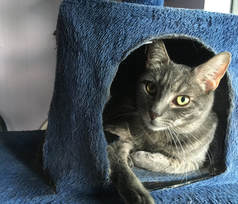 In Boston, Mass, in 1984, Annabell, who was working on Martha’s Vineyard with PAWS, an organization she had founded a decade earlier, had attended a conference of the World Society for the Protection of Animals and heard Peter Neville from the U.K. who studied feral cats for many years, speak about the success of TNR in Britain. Later in 1985, while vacationing at her house on the Virgin Gorda islands, she discovered several colonies of cats. For the next decade she took Tufts veterinary students to conduct TNR on the island. In the July 1990 issue of Cat Fancy, another great friend and TNR advocate, author Ellen Perry Berkeley wrote the article Feral Cats, highlighting a few ground-breaking programs tackling the feral cat issue including Annabell’s dedicated work. I immediately reached out to both women, as I had been working on a feral cat colony in Adams Morgan, Washington D.C. and had discovered the bias and animosity towards feral cats by the animal movement at that time. Annabell called me right away after receiving my letter, and her and her husband, Stanley drove down to Maryland to meet me. Annabell was ecstatic that I was thinking of starting the first national organization to promote and advocate TNR, Alley Cat Allies. In 1997 I founded Alley Cat Rescue, having left Alley Cat Allies, and Annabell and I continued our friendship and she helped financially to start ACR. Over the years we often spoke together on panel discussions on TNR and developed an amazing friendship and bond. She called me at least twice a month over the years, and we had a lot of laughs about our work and the initial reaction to TNR by major groups. One CEO of a national animal group, when he heard Annabell was doing TNR said to her: “oh so you have become a cat hoarder”. I shared with her how I had been called many things on my rounds to debate TNR with folks from major animal organizations saying I was “dumping” cats, and my TNR was illegal, and calling me all kinds of names as well. We both held on to our firm belief that what we were doing was ethically right and moral, and that they would all learn this in the future. Which in fact become true as one by one over the years, they changed their minds and started advocating for TNR. She shared funny stories of her and Stanley leaving to vacation on Martha’s Vineyard and the battle they had rounding up her dozen cats, many feral, in their apartment in New York City to go with them to the Island. I recently visited her in New York City after she had suffered a stroke, and she had had a bad day and did not really remember me. But we chatted and I had breakfast with her. Then in 2015 a miracle happened. My phone rang and I saw it was A’Bell’s phone number. At first I was afraid to answer the phone expecting the worst. But I picked up and it was the old Annabell calling me! She had just received a copy of my Handbook I had written, and she was calling to congratulate me on the book and saying how much she enjoyed it! We chatted a long time. But a week later when I called her again, she was back to struggling with her memory and said: “Well if you say you are a friend, you must be a cat person!” Rest in peace Dear Friend. One person told her once when they talked about growing old: “Annabell God is probably a big black cat!”
3 Comments
 Hawaii’s House and Senate are hearing bills that put community cats at risk and violate citizens’ privacy. House Bills 606 and 454 and Senate Bill 637 allow the state to enter private properties and eradicate who they deem pests, which includes community cats, in non-humane ways. Unfortunately, the next step for bill 606 is for Gov. David Ige to sign or veto the legislation. We urge our supporters to contact Gov. Ige at 808-586-0034 and tell him you vehemently oppose any legislation that discourages humane treatment of America’s favorite animal. The Department of Agriculture or the county will give the resident five days notice “to enter the property for the control or eradication of a pest,” according to the bill, whether the resident likes it or not. Invading people's’ homes and properties would fail to get to the root of overpopulation. Cat populations can be managed with Trap-Neuter-Return, as proved by an Alley Cat Rescue Survey that found more than 50 percent of feeders cared for colonies less than 20 with the help of TNR in 2016. Before TNR was as prevalent, in 2012, only 35 percent of feeders cared for colonies less than 20. Officials who eradicate feral cats don’t consider that once they eliminate a colony, another will take its place. If there are still cats who aren’t spayed and neutered, they will simply replace an eradicated colony with its own population. It’s an endless, fruitless cycle that harms human and cat lives. But Hawaii has considered TNR as well. House Bill 191 would establish feral cat overpopulation programs in high schools, which includes TNR, the most effective and humane way to reduce feral cat populations. House Bill 122 similarly supports TNR and would allot government money toward TNR. Though bills 191 and 122 aren’t close to reaching the governor’s desk, they properly address community cat populations, and Hawaii’s House should further consider them. Perhaps Hawaii’s government should listen to their own Invasive Species Council when it suggests to spay and neuter cats to help manage the population, rather than inhumanely eradicate community cats. To act, mail Gov. Ige at: Office of the Governor The Honorable David Y. Ige Governor, State of Hawaii Executive Chambers State Capitol Honolulu, Hawaii 96813 |
Details
AuthorAlley Cat Rescue is leading in the way in promoting humane and compassionate care for ALL cats. Archives
April 2024
Categories
All
|
 RSS Feed
RSS Feed